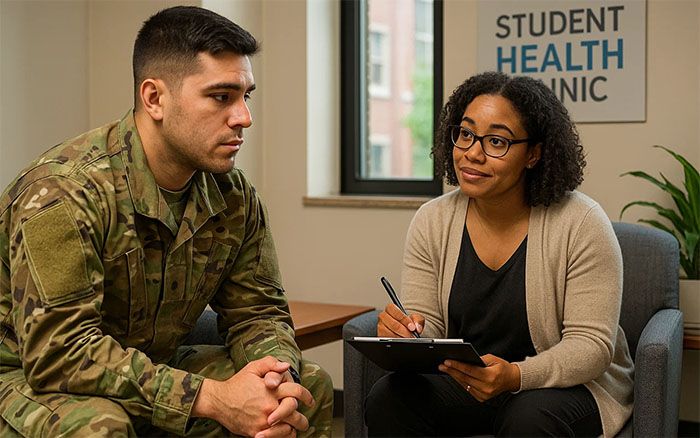Mind-Body Interventions: How Yoga, Meditation, and Breathing Exercises Improve Student Health
Late-night study sessions. Mounting debt. Constant pressure to perform. It’s no wonder today’s students are reporting record levels of stress and anxiety. In fact, the American College Health Association’s Spring 2024 national survey revealed that over 76% of students report moderate to high levels of stress, and nearly half experience overwhelming anxiety.
For college health and counseling clinics, these numbers highlight the urgent need for accessible, preventative wellness strategies. And one effective solution lies in mind-body interventions. Practices like yoga, meditation, and controlled breathing help regulate stress while improving physical and mental well-being.
In this blog, we’ll explore what mind-body interventions really are and share practical strategies for bringing them to your campus.
What Are Mind-Body Interventions?
Mind-body interventions are techniques that use the connection between mental focus and physical state to promote healing and resilience. Unlike traditional treatments that address symptoms in isolation, these practices target the underlying stress response.
Some of the most widely adopted include:
- Yoga: Combines physical postures, controlled breathing, and mindfulness.
- Meditation: Focused attention practices that calm racing thoughts and improve emotional regulation.
- Breathing Exercises: Simple techniques like box breathing or diaphragmatic breathing that stabilize heart rate and nervous system activity.
- Massage Therapy: Physical manipulation of muscles and soft tissue to improve circulation, decrease anxiety, and support overall mind-body balance.
These interventions are low-cost, non-invasive, and adaptable, making them ideal for a higher education setting where accessibility and inclusivity are key.
The Benefits of Mind-Body Practices for Students
The impact of stress on students extends far beyond mental strain. Chronic stress is linked to poor sleep, weakened immunity, and impaired cognitive function which can lead to lower academic performance. By integrating mind-body interventions into campus wellness initiatives, institutions can help students build healthier coping mechanisms that prevent crisis-level care needs.
1. Mental Health Improvements
A growing body of research shows that yoga and meditation significantly reduce symptoms of anxiety and depression in college students. One study in the Journal of American College Health found that students participating in an 8-week mindfulness program reported decreased stress and improved mood regulation.
2. Academic and Cognitive Gains
Moreover, mindfulness practices have been linked to better concentration, working memory, and executive functioning—all crucial for academic success. Regular meditation practice can help students feel calmer, more grounded, and better able to manage stressful times like exam weeks.
3. Physical Health Benefits
Mind-body practices don’t just calm the mind; they also improve the body’s resilience. Yoga can reduce back pain from long study sessions, improve posture, and alleviate headaches or digestive issues exacerbated by stress.
Furthermore, breathing exercises can lower blood pressure and improve heart health, overall improving symptoms associated with anxiety.
4. Healthy Coping and Resilience
Instead of relying on quick fixes like caffeine, students can turn to breathing exercises and meditation as practical, on-the-spot strategies.
Whether it’s before a big exam, after a conflict, or during a stressful moment, these practices help build lasting coping skills and resilience.
Practical Strategies for Campus Integration
Bringing mind-body interventions to campus doesn’t have to mean building a yoga studio or adding entirely new programs. Instead, colleges can embed these practices into existing health, counseling, and student life structures in ways that feel natural and inclusive.
Embedding Practices in College Health Clinics
Health clinics are often a student’s first stop when stress shows up as headaches, fatigue, or stomach issues. Clinics can use these moments to introduce students to practical mind-body tools.
For example, a provider might demonstrate a simple two-minute breathing exercise during an appointment or recommend yoga as part of a care plan for stress-related physical symptoms.
On a larger scale, clinics can display calming guided breathing videos in waiting areas, offer digital resources through patient portals, and share recommendations for trusted mindfulness or yoga apps. By weaving these interventions into medical care, students see stress management as part of overall health—not a separate, optional practice.
Expanding Counseling & Wellness Services
Counseling centers are uniquely positioned to integrate mind-body approaches into therapy. Counselors can open sessions with a brief meditation, use breathing exercises to help students ground themselves in moments of high anxiety, or suggest yoga in addition to talk therapy.
Beyond one-on-one care, wellness staff can host drop-in meditation groups or partner with recreation departments to co-sponsor yoga workshops. Training peer wellness leaders to guide short mindfulness practices can also help extend reach and reduce stigma, making these interventions more approachable for students who may be hesitant to seek counseling.
P.S. Check out three experts’ top tips for collaborating with other departments on campus.
Leveraging Technology to Support Mind-Body Interventions
Furthermore, technology can amplify the reach of these practices. With the right tools, staff can easily recommend and reinforce mind-body strategies:
- Campus EHR systems can deliver post-visit resources or promote upcoming workshops through secure messaging.
- Automated appointment reminders can include quick stress-reduction tips to engage students before their visit.
- Telehealth services allow providers to guide students through breathing or mindfulness exercises virtually, ensuring continuity of care.
Key Takeaways
The key to lasting impact is consistency. When students see yoga, meditation, and breathing exercises woven into the fabric of campus life, they’re more likely to adopt them as daily habits. Over time, this builds a healthier, more resilient student body and reduces demand for crisis services.
By supporting both reactive care (counseling sessions, medical visits) and preventive care (mind-body interventions, wellness education), institutions can move closer to a truly holistic model of student well-being.
Ready to bring holistic care to your campus?
















